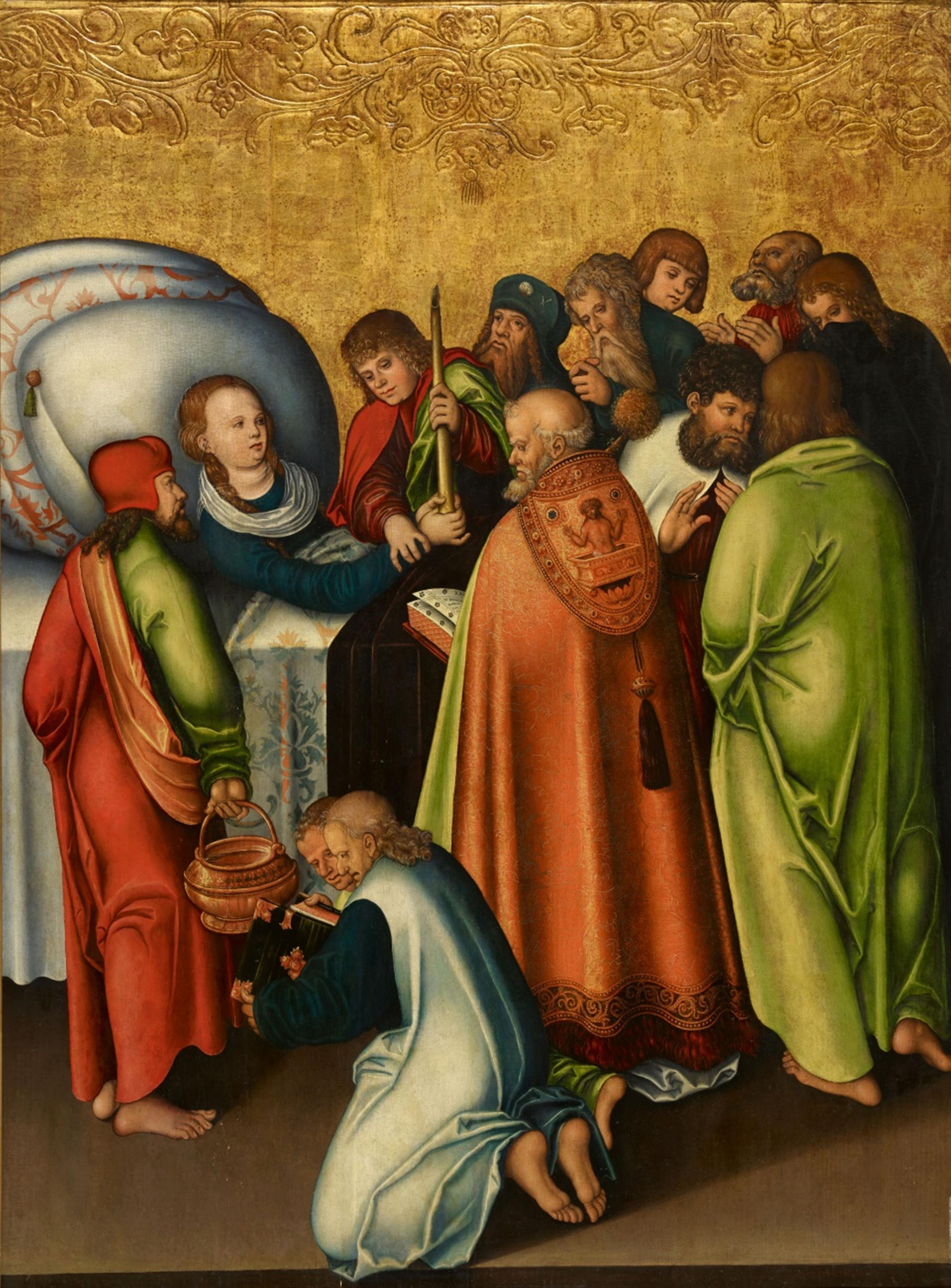Master of the Pflock Altarpiece
The Death of the Virgin
Oil on panel (parquetted). 158 x 116 cm.
This large-format panel was originally made for an altarpiece. A gold background with embossed floral decor, acanthus scrolls, delicate curved branches with trefoil leaves, five-petalled flowerheads and a central tassel occupies the upper section of the work. Beneath this ornamental background - still firmly rooted in the Gothic tradition - we see the Virgin's bed in the left half of the image. Her head is propped up on three pillows, and Her face is depicted in a youthful and idealised manner. A fine, sheer veil covers Her golden brown, wavy hair, and the neckline of Her dress is inscribed “MARIA + MATE[R DEI]“ (Mary, mother of God).
The apostles are shown grouped around the Virgin. The youngest, John the Baptist, helps Her support the candle that She holds in both hands. James the Greater is shown behind him, recognisable by his pilgrim's hat with a scallop shell. Saint Peter stands with his back to the beholder. He wears a gold brocade cope with an embroidered, pearl and gem encrusted depiction of Christ rising from the dead on the hood, from which hangs a tasselled pomander. He looks thoughtfully towards the dying Madonna over the bible perched on the edge of the bed, and holds aloft an aspergillum in his right hand. A further apostle stands to his left holding the aspersorium. The other apostles are depicted in small group or in pairs, engrossed in conversation or in prayer.
Many of Lucas Cranach the Elder's pupils left his studio in Wittenberg to prove themselves alone and develop their own personal style and brushwork. Among these pupils was the Master of the Pflock Altarpiece, whose provisional name derives from the Pflock family altar in the church of St. Annen in Annaberg. The name was first used by Friedländer and Rosenberg in their catalogue raisonné of the works of Lucas Cranach the Elder in 1932.
Whilst over 1,500 works are today attributed to Lucas Cranach, the oeuvre of the Master of the Pflock Altarpiece encompasses just a handful of paintings and altars. Although research on Cranach and his pupils has increased greatly in the last few years, the question of differentiation between the hands of the master and his workshop is still a hotly disputed and widely researched field. A few years ago, the general assumption was established that the Master of the Pflock Altarpiece moved to Annaberg in around 1515, after working in Cranach's workshop from 1510 - 1515. Whether or not he also began an apprenticeship there could not yet be established.
Works by this master created after his departure from the Wittenberg studio display a unique and individual style of their own, despite the obvious links to Cranach's oeuvre. The same applies to this depiction of the death of the Virgin: the closeness to Cranach's style but simultaneous differences in the manner of depicting the heads, the marked clarity of the forms and colours, the light colour palette and use of finely graduated glaze techniques all point to this artist. This large altar panel was definitely created in the Erzgebirge after 1515, perhaps even between 1518 and 1523, when the Master of the Pflock Altarpiece had already distanced himself from Cranach's studio and begun to work independently.
According to the previous owner, Ernst Buchner produced an expertise on 12th October 1954 attributing the piece to Lucas Cranach the Elder and dating it to around 1518. However, one of the most prominent Cranach specialists, Dieter Koepplin, later attributed the piece to the Master of the Pflock Altarpiece in an essay (cf. Koepplin 1972, p. 346). In a letter dated 27th March 2010, Ingo Sandner, author of several publications on Cranach, also confirms the attribution to the Master of the Pflock Altarpiece. In her 2013 master's thesis, Laura Thiepold also attributes this work to the same master, and dates it to his Erzgebirge period after the master worked in the studio of Lucas Cranach (cf. Thiepold 2013, p. 130).
Provenance
Julius Böhler, Munich, ca. 1900. - Auctioned by Lamm, New York, 21.02.1923, lot 637. - Auctioned by Parke Bernet, New York, 24.10.1946, lot 54. - Auctioned by Neumeister, Munich, 29.06.1994, lot 407. - Georg Schäfer Collection, Schweinfurt. - Henceforth in a North German private collection.
Literature
Max J. Friedländer/Jabob Rosenberg: Die Gemälde von Lucas Cranach, Berlin, 1932, no. 93b. - Charles L. Kuhn: A catalogue of German Paintings in American Collections, Cambridge, 1936, no. 413. - Dieter Koepplin: Kunstchronik, XXV München, 1972, p. 346. - Max J. Friedländer/Jacob Rosenberg, Die Gemälde von Lucas Cranach, London, 1978, no. 106c. - Laura Thiepold: Der Epitaphaltar des Stifters Ambrosius Hermsdorff in der Kunigundenkirche zu Rochlitz, Masterarbeit, Heinrich-Heine-Universität Düsseldorf, 2013, p.1, 78, 130.

